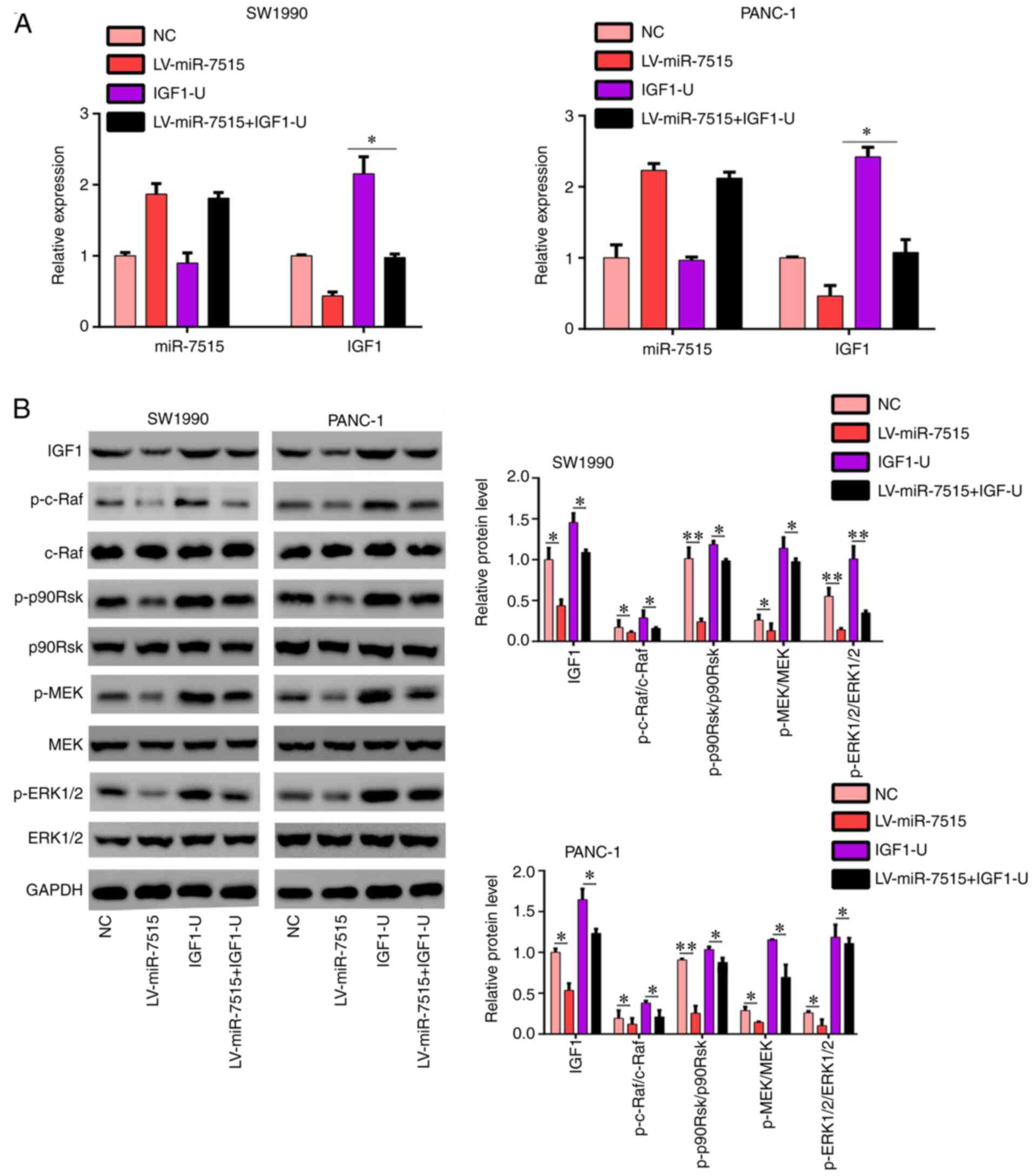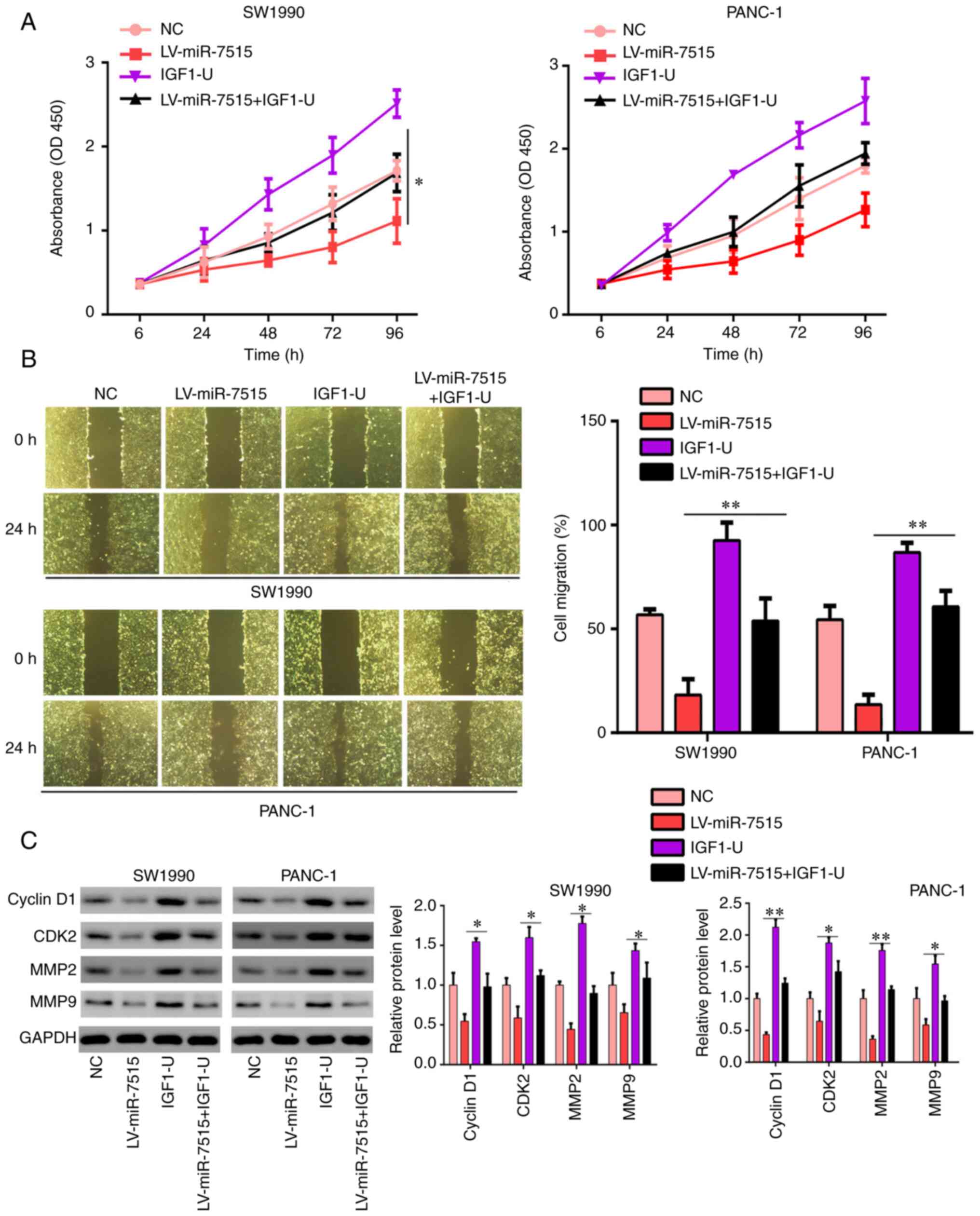|
1
|
Riquelme E, Zhang Y, Zhang L, Montiel M,
Zoltan M, Dong W, Quesada P, Sahin I, Chandra V, Lucas AS, et al:
Tumor microbiome diversity and composition influence pancreatic
cancer outcomes. Cell. 178:795–806. 2019. View Article : Google Scholar : PubMed/NCBI
|
|
2
|
McGuigan A, Kelly P, Turkington RC, Jones
C, Coleman HG and McCain RS: Pancreatic cancer: A review of
clinical diagnosis, epidemiology, treatment and outcomes. World J
Gastroenterol. 24:4846–4861. 2018. View Article : Google Scholar : PubMed/NCBI
|
|
3
|
Mendt M, Kamerkar S, Sugimoto H, McAndrews
KM, Wu CC, Gagea M, Yang S, Blanko EV, Peng Q, Ma X, et al:
Generation and testing of clinical-grade exosomes for pancreatic
cancer. JCI Insight. 19:e992632018. View Article : Google Scholar : PubMed/NCBI
|
|
4
|
Liu GF, Li GJ and Zhao H: Efficacy and
toxicity of different chemotherapy regimens in the treatment of
advanced or metastatic pancreatic cancer: A network meta-analysis.
J Cell Biochem. 119:511–523. 2018. View Article : Google Scholar : PubMed/NCBI
|
|
5
|
Srikok S, Patchanee P, Boonyayatra S and
Chuammitri P: Potential role of MicroRNA as a diagnostic tool in
the detection of bovine mastitis. Prev Vet Med. 182:1051012020.
View Article : Google Scholar : PubMed/NCBI
|
|
6
|
Kagiya T: MicroRNAs: Potential biomarkers
and therapeutic targets for alveolar bone loss in periodontal
disease. Int J Mol Sci. 17:13172016. View Article : Google Scholar : PubMed/NCBI
|
|
7
|
Aslan M, Shahbazi R, Ulubayram K and
Ozpolat B: Targeted therapies for pancreatic cancer and hurdles
ahead. Anticancer Res. 38:6591–6606. 2018. View Article : Google Scholar : PubMed/NCBI
|
|
8
|
Qu K, Zhang X, Lin T, Liu T, Wang Z, Liu
S, Zhou L, Wei J, Chang H, Li K, et al: Circulating miRNA-21-5p as
a diagnostic biomarker for pancreatic cancer: Evidence from
comprehensive miRNA expression profiling analysis and clinical
validation. Sci Rep. 7:16922017. View Article : Google Scholar : PubMed/NCBI
|
|
9
|
Tu MJ, Ho PY, Zhang QY, Jian C, Qiu JX,
Kim EJ, Bold RJ, Gonzalez FJ, Bi H and Yu AM: Bioengineered
miRNA-1291 prodrug therapy in pancreatic cancer cells and
patient-derived xenograft mouse models. Cancer Lett. 442:82–90.
2019. View Article : Google Scholar : PubMed/NCBI
|
|
10
|
Yu Z, Zhao S, Wang L, Wang J and Zhou J:
miRNA-339-5p plays an important role in invasion and migration of
pancreatic cancer cells. Med Sci Monit. 25:7509–7517. 2019.
View Article : Google Scholar : PubMed/NCBI
|
|
11
|
Yang Y, Sun Y, Wang H, Li H, Zhang M, Zhou
L, Meng X, Wu Y, Liu P, Liu X, et al: MicroRNA-221 induces
autophagy through suppressing HDAC6 expression and promoting
apoptosis in pancreatic cancer. Oncol Lett. 16:7295–7301.
2018.PubMed/NCBI
|
|
12
|
Lv F, Zheng K, Yu J and Huang Z:
MicroRNA-661 expression is upregulated in pancreatic ductal
adenocarcinoma and promotes cell proliferation. Oncol Lett.
16:6293–6298. 2018.PubMed/NCBI
|
|
13
|
Zhang X, Shi H, Lin S, Ba M and Cui S:
MicroRNA-216a enhances the radiosensitivity of pancreatic cancer
cells by inhibiting beclin-1-mediated autophagy. Oncol Rep.
34:1557–1564. 2015. View Article : Google Scholar : PubMed/NCBI
|
|
14
|
Sun Y, Zhu Q, Zhou M, Yang W, Shi H, Shan
Y, Zhang Q and Yu F: Restoration of miRNA-148a in pancreatic cancer
reduces invasion and metastasis by inhibiting the wnt/β-catenin
signaling pathway via downregulating maternally expressed gene-3.
Exp Ther Med. 17:639–648. 2019.PubMed/NCBI
|
|
15
|
Mutgan AC, Besikcioglu HE, Wang S, Friess
H, Ceyhan GO and Demir IE: Insulin/IGF-driven cancer cell-stroma
crosstalk as a novel therapeutic target in pancreatic cancer. Mol
Cancer. 17:662018. View Article : Google Scholar : PubMed/NCBI
|
|
16
|
Rozengurt E: Mechanistic target of
rapamycin (mTOR): A point of convergence in the action of
insulin/IGF-1 and G protein-coupled receptor agonists in pancreatic
cancer cells. Front Physiol. 5:3572014. View Article : Google Scholar : PubMed/NCBI
|
|
17
|
Yakovenko A, Cameron M and Trevino JG:
Molecular therapeutic strategies targeting pancreatic cancer
induced cachexia. World J Gastrointest Surg. 10:95–106. 2018.
View Article : Google Scholar : PubMed/NCBI
|
|
18
|
Takahashi T, Ichikawa H, Morimoto Y,
Tsuneyama K and Hijikata T: Inhibition of EP2/EP4 prostanoid
receptor-mediated signaling suppresses IGF-1-induced proliferation
of pancreatic cancer BxPC-3cells via upregulating γ-glutamyl
cyclotransferase expression. Biochem Biophys Res Commun.
516:388–396. 2019. View Article : Google Scholar : PubMed/NCBI
|
|
19
|
Livak KJ and Schmittgen TD: Analysis of
relative gene expression data using real-time quantitative PCR and
the 2(-Delta Delta C(T)) method. Methods. 25:402–408. 2001.
View Article : Google Scholar : PubMed/NCBI
|
|
20
|
National Research Council (US) Committee
for the Update of the Guide for the Care and Use of Laboratory
Animals, . Guide for the Care and Use of Laboratory Animals.
National Academies Press (US); Washington, DC: 2011
|
|
21
|
Lei S, He Z, Chen T, Guo X, Zeng Z, Shen Y
and Jiang J: Long noncoding RNA 00976 promotes pancreatic cancer
progression through OTUD7B by sponging miR-137 involving EGFR/MAPK
pathway. J Exp Clin Cancer Res. 38:4702019. View Article : Google Scholar : PubMed/NCBI
|
|
22
|
Nagathihalli NS, Castellanos JA,
Lamichhane P, Messaggio F, Shi C, Dai X, Rai P, Chen X, Vansaun MN
and Merchant NB: Inverse correlation of STAT3 and MEK signaling
mediates resistance to RAS pathway inhibition in pancreatic cancer.
Cancer Res. 78:6235–6246. 2018. View Article : Google Scholar : PubMed/NCBI
|
|
23
|
Wu SZ, Xu HC, Wu XL, Liu P, Shi YC, Pang
P, Deng L, Zhou GX and Chen XY: Dihydrosanguinarine suppresses
pancreatic cancer cells via regulation of mut-p53/WT-p53 and the
Ras/Raf/Mek/Erk pathway. Phytomedicine. 59:1528952019. View Article : Google Scholar : PubMed/NCBI
|
|
24
|
Xu L, Yuan X, Ni J, Shen L, Cai M and
Jiang D: Gain of microRNA-103 triggers metastatic behavior by
targeting ubiquitin specific peptidase 10 in pancreatic cancer. Int
J Clin Exp Pathol. 12:1214–1223. 2019.PubMed/NCBI
|
|
25
|
Lee JM, Yoo JK, Yoo H, Jung HY, Lee DR,
Jeong HC, Oh SH, Chung HM and Kim JK: The novel miR-7515 decreases
the proliferation and migration of human lung cancer cells by
targeting c-Met. Mol Cancer Res. 11:43–53. 2013. View Article : Google Scholar : PubMed/NCBI
|
|
26
|
Chong GO, Jeon HS, Han HS, Son JW, Lee YH,
Hong DG, Lee YS and Cho YL: Differential MicroRNA expression
profiles in primary and recurrent epithelial ovarian cancer.
Anticancer Res. 35:2611–2617. 2015.PubMed/NCBI
|
|
27
|
Dey S, Liu S, Factora TD, Taleb S,
Riverahernandez P, Udari L, Zhong X, Wan J and Kota J: Global
targetome analysis reveals critical role of miR-29a in pancreatic
stellate cell mediated regulation of PDAC tumor microenvironment.
BMC Cancer. 20:6512020. View Article : Google Scholar : PubMed/NCBI
|
|
28
|
Yang SY, Miah A, Pabari A and Winslet M:
Growth factors and their receptors in cancer metastases. Front
Biosci (Landmark Ed). 16:531–538. 2011. View Article : Google Scholar : PubMed/NCBI
|
|
29
|
Hwang HJ, Oh MS, Lee DW and Kuh HJ:
Multiplex quantitative analysis of stroma-mediated cancer cell
invasion, matrix remodeling, and drug response in a 3D co-culture
model of pancreatic tumor spheroids and stellate cells. J Exp Clin
Cancer Res. 38:2582019. View Article : Google Scholar : PubMed/NCBI
|
|
30
|
Kopantzev EP, Kopantseva MR, Grankina EV,
Mikaelyan A, Egorov VI and Sverdlov ED: Activation of IGF/IGF-IR
signaling pathway fails to induce epithelial-mesenchymal transition
in pancreatic cancer cells. Pancreatology. 19:390–396. 2019.
View Article : Google Scholar : PubMed/NCBI
|
|
31
|
Bertrand FE, Steelman LS, Chappell WH,
Abrams SL, Shelton JG, White ER, Ludwig DL and McCubrey JA: Synergy
between an IGF-1R antibody and Raf/MEK/ERK and PI3K/Akt/mTOR
pathway inhibitors in suppressing IGF-1R-mediated growth in
hematopoietic cells. Leukemia. 20:1254–1260. 2006. View Article : Google Scholar : PubMed/NCBI
|
|
32
|
Catalanotto C, Cogoni C and Zardo G:
MicroRNA in control of gene expression: An overview of nuclear
functions. Int J Mol Sci. 17:17122016. View Article : Google Scholar : PubMed/NCBI
|


















